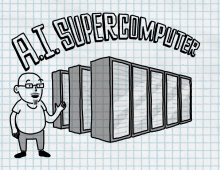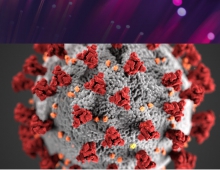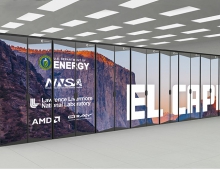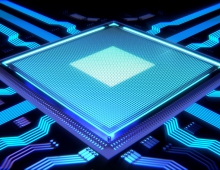
Oak Ridge Titan Is The World's Top Supercomputer
Reports that Oak Ridge National Laboratory was fielding the world's fastest supercomputer were proven correct when the 40th edition of the twice-yearly TOP500 List of the world's top supercomputers was released today.
Titan, a Cray XK7 system installed at Oak Ridge, achieved 17.59 Petaflop/s (quadrillions of calculations per second) on the Linpack benchmark. Titan has 560,640 processors, including 261,632 NVIDIA K20x accelerator cores.
In claiming the top spot, Titan knocked Lawrence Livermore National Laboratory's Sequoia out of No. 1 and into second place. Sequoia, an IBM BlueGene/Q system, was No. 1 in June 2012 with a 16.32 Petaflop/s on the Linpack benchmark. With 1,572,864 cores, Sequoia is the first system with one million or more cores.
Rounding out the top five systems are Fujitsu's K computer installed at the RIKEN Advanced Institute for Computational Science (AICS) in Kobe, Japan (No. 3); a BlueGene/Q system named Mira at Argonne National Laboratory (No. 4); and a BlueGene/Q system named JUQUEEN at the Forschungszentrum Juelich in Germany (No. 5), which was upgraded and is now the most powerful system in Europe.
The other new system in the Top 10 is Stampede, a Dell PowerEdge C8220 system installed at the Texas Advanced Computing Center at the University of Texas in Austin. It uses the brand new Intel Xeon Phi processors (previously known as MIC) to achieve its 2.6 Petaflop/s.
In all there are 23 systems with Petaflop/s performance on the latest list, just four-and-a-half years after the debut of Roadrunner, the world?s first Petaflop/s supercomputer. In spite of delivering petascale performance on applications, the Cray Blue Waters system at NCSA at the University of Illinois, Urbana-Champaign, chose not to submit a Linpack benchmark performance figure.
A total of 62 systems on the list are using accelerator/Co-Processor technology, including Titan and the Chinese Tianhe-1A system (No. 8), which use NVIDIA GPUs to accelerate computation and Stampede and six others, which are accelerated by the new Intel Xeon Phi processors. Six months ago, 58 systems used accelerators or co-processors.
Systems with multi-core processors dominate the list?84.6 percent of the systems use processors with six or more cores and 46.2 percent with eight or more cores.
Intel continues to provide the processors for the largest share (76 percent) of TOP500 systems. Intel is followed by the AMD Opteron family with 60 systems (12 percent), the same as six months ago. IBM Power processors are used in 53 systems (10.6 percent).
InfiniBand technology now provides interconnects on 226 systems, up from 209 systems, making it the most-used internal system interconnect technology. Gigabit Ethernet interconnects are now found on 188 systems, down from207 six months ago.
The U.S. is the leading consumer of HPC systems with 250 of the 500 systems. The European share is still lower than the Asian share. The number of systems installed in China has now stabilized at 72. China occupies the No. 2 position as a user of HPC, ahead of Japan, UK, France, and Germany. When it comes to performance share of the list, however, Japan holds the No. 2 position, ahead of China.
The TOP500 list is compiled by Hans Meuer of the University of Mannheim, Germany; Erich Strohmaier and Horst Simon of Lawrence Berkeley National Laboratory; and Jack Dongarra of the University of Tennessee, Knoxville.
In claiming the top spot, Titan knocked Lawrence Livermore National Laboratory's Sequoia out of No. 1 and into second place. Sequoia, an IBM BlueGene/Q system, was No. 1 in June 2012 with a 16.32 Petaflop/s on the Linpack benchmark. With 1,572,864 cores, Sequoia is the first system with one million or more cores.
Rounding out the top five systems are Fujitsu's K computer installed at the RIKEN Advanced Institute for Computational Science (AICS) in Kobe, Japan (No. 3); a BlueGene/Q system named Mira at Argonne National Laboratory (No. 4); and a BlueGene/Q system named JUQUEEN at the Forschungszentrum Juelich in Germany (No. 5), which was upgraded and is now the most powerful system in Europe.
The other new system in the Top 10 is Stampede, a Dell PowerEdge C8220 system installed at the Texas Advanced Computing Center at the University of Texas in Austin. It uses the brand new Intel Xeon Phi processors (previously known as MIC) to achieve its 2.6 Petaflop/s.
In all there are 23 systems with Petaflop/s performance on the latest list, just four-and-a-half years after the debut of Roadrunner, the world?s first Petaflop/s supercomputer. In spite of delivering petascale performance on applications, the Cray Blue Waters system at NCSA at the University of Illinois, Urbana-Champaign, chose not to submit a Linpack benchmark performance figure.
A total of 62 systems on the list are using accelerator/Co-Processor technology, including Titan and the Chinese Tianhe-1A system (No. 8), which use NVIDIA GPUs to accelerate computation and Stampede and six others, which are accelerated by the new Intel Xeon Phi processors. Six months ago, 58 systems used accelerators or co-processors.
Systems with multi-core processors dominate the list?84.6 percent of the systems use processors with six or more cores and 46.2 percent with eight or more cores.
Intel continues to provide the processors for the largest share (76 percent) of TOP500 systems. Intel is followed by the AMD Opteron family with 60 systems (12 percent), the same as six months ago. IBM Power processors are used in 53 systems (10.6 percent).
InfiniBand technology now provides interconnects on 226 systems, up from 209 systems, making it the most-used internal system interconnect technology. Gigabit Ethernet interconnects are now found on 188 systems, down from207 six months ago.
The U.S. is the leading consumer of HPC systems with 250 of the 500 systems. The European share is still lower than the Asian share. The number of systems installed in China has now stabilized at 72. China occupies the No. 2 position as a user of HPC, ahead of Japan, UK, France, and Germany. When it comes to performance share of the list, however, Japan holds the No. 2 position, ahead of China.
The TOP500 list is compiled by Hans Meuer of the University of Mannheim, Germany; Erich Strohmaier and Horst Simon of Lawrence Berkeley National Laboratory; and Jack Dongarra of the University of Tennessee, Knoxville.



















